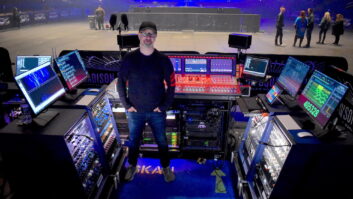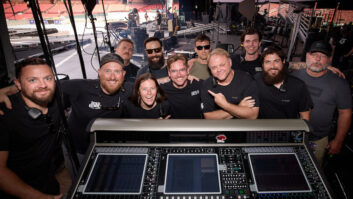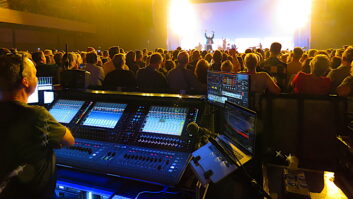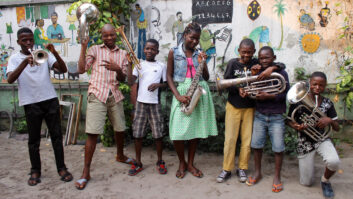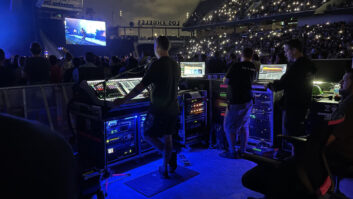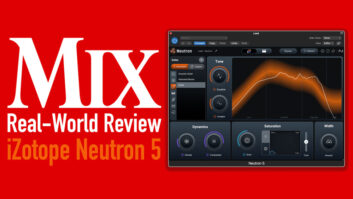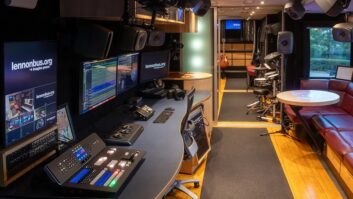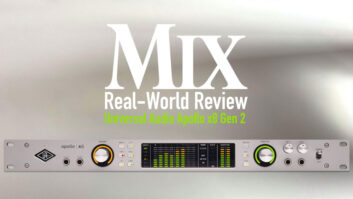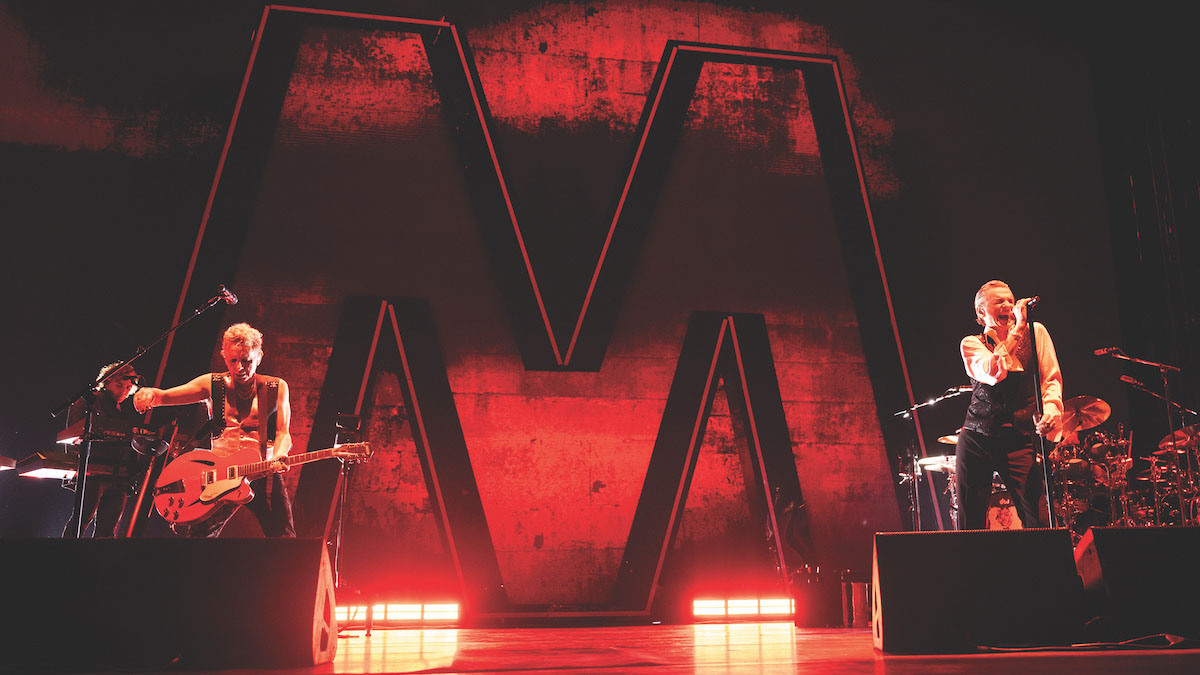
New York, NY (January 16, 2024)—Depeche Mode knows a little something about music for the masses. Deep in the middle of a year-long world tour that kicks off Leg 4 in London on January 22, the group continues to bring its unique blend of synth pop, goth, alternative, rock and more to sold-out stadiums and arenas. The band—now a duo of vocalist Dave Gahan and multi-instrumentalist/vocalist Martin Gore—has been on the road in support of 2022’s Memento Mori, and supporting Depeche Mode’s modus operandi at every stop has been UK-based audio provider Britannia Row Productions, which has now worked with the band for 30 years.
Along for the ride are FOH engineer Jamie Pollock and monitor engineer Mike Gibbard, each ensuring that their mixes reflect what’s happening onstage with clarity and purpose. Depeche Mode has never held the recorded versions of its songs as sacrosanct, as evidenced by the bumper crop of remixes the group has released over the years. Bringing that philosophy to the FOH position, Pollock had to develop each song’s mix not necessarily to reproduce the recorded version or simply give it a more “live feel,” but instead to best support the song’s latest evolution.
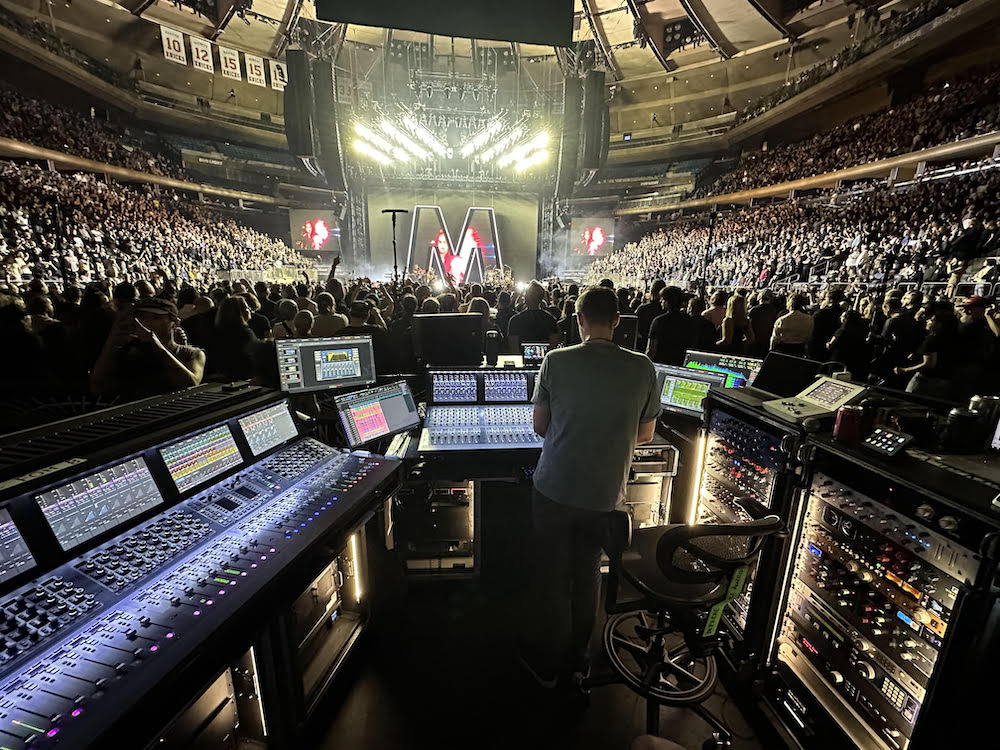
“I could play you one of their songs that everyone knows, mute the lead parts to listen to what’s underneath it—and you’d say, ‘It’s not the same song,’” he said, laughing. “The music is so creative, and there’s so many layers to it; it’s quite brilliant. I spent some time with Daniel Miller, the founder of Mute Records, who discovered them, and we had conversations about how some songs came about in the studio. You think you know what drives a song and you interpret it that way, but there’s definitely been times where I was wrong. He was able to tell me about a song’s creative process, and once you understand the fundamentals of what it was about, you can then play on it [in the mix]. I think they look for things that make it exciting, a little different. We recently started playing ‘Black Celebration,’ and how we’re doing it now is very different—and they wanted that. I think they were looking for something a bit new and fresh, and that’s the evolution.”
The front-of-house mix position has a similar vibe—there’s plenty of familiar gear on-hand, much of it analog, but the way it’s all brought together is a new approach. Pollock mixes nightly on an Avid S6L-32D console, with a backup desk sitting nearby in case of emergency.
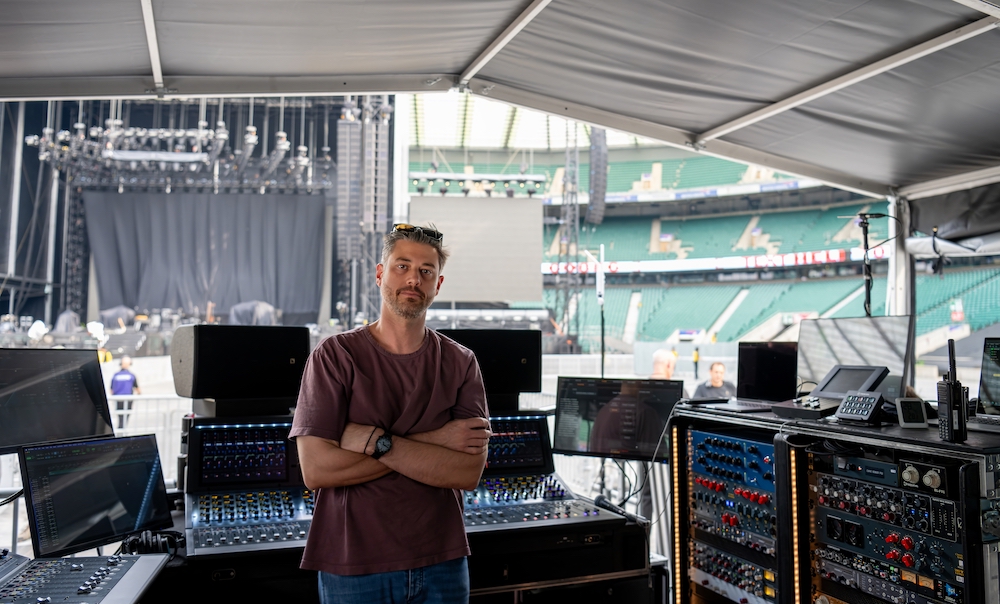
Given the size of the tour, playing stadiums and arenas, he wanted to have “an insurance policy” as he put it, where he could switch consoles instantly if needed. As a result, the two desks gain-share a pair of Stage 64 racks on stage for analog inputs; additionally, various RME MADI routers on stage distribute digital MADI sources to both E6L-192 engines.
“I’m sending a lot of MIDI commands back and forth between the two consoles, so every time I fire a snapshot, it also fires on the second desk,” said Pollock. “Both consoles go into a DirectOut Prodigy MC, and that is actually driving everything. All my analog outboard gear and Schoeps audience mics go into the Prodigy, so there’s a lot of routing back and forth, and I’ve set it up so that if I hit a button on my Elgato Stream Deck, it’ll switch the MADI patch, moving everything to the backup console.”
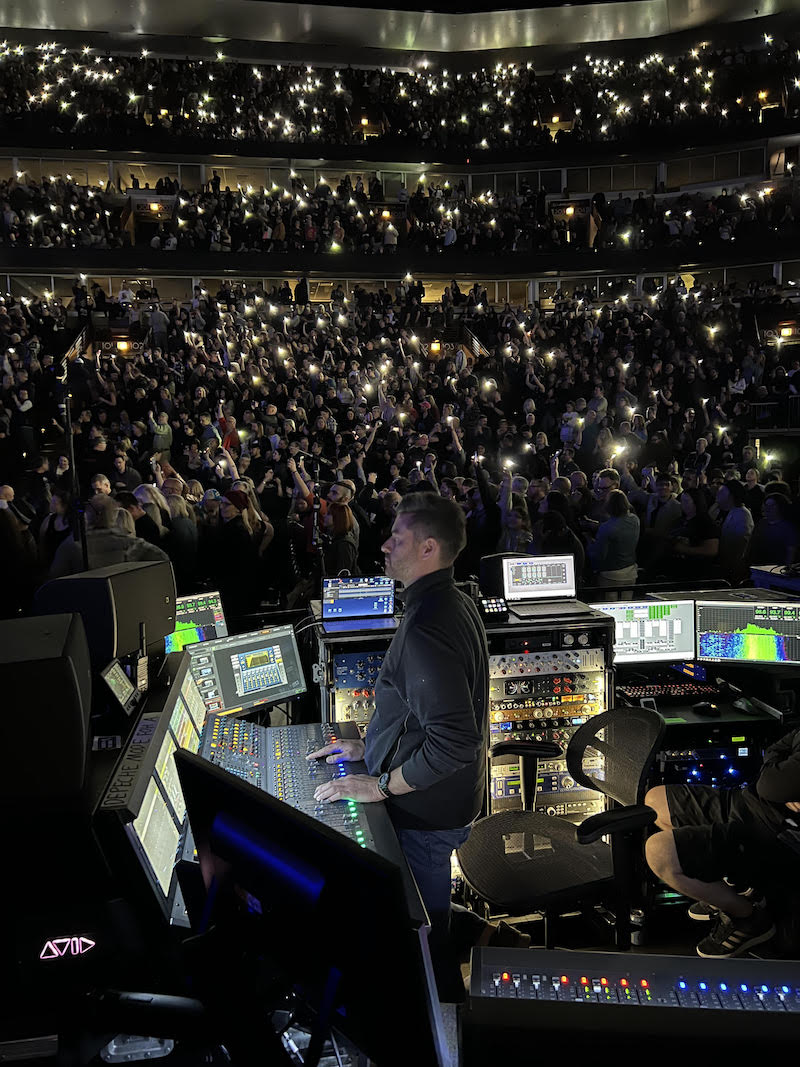
When it comes to that outboard gear, there’s plenty to get moved over. For the all-important vocals, there’s a pair of Rupert Neve Designs 5045 primary source enhancers and Shelford Channels, used to squeeze out a little more gain before feedback when the group heads out onto the stage thrust. A shorter plate reverb from a Bricasti M7 gets applied to Gahan’s vocal for some depth, and a tc electronic System 6000 reverb gets blended in with it for character as needed. While an Overstayer Modular Channel was originally going to be part of the vocal setup, it ultimately landed on the guitar, next to a GML 8900 dynamic range controller. “I try to put a range of colors on my palette that I know I can use if needed, and that’s an example,” said Pollock. “The Overstayer is a good piece; it always shapes things well, has a lot of parallel paths, and has plenty of flexibility. It’s really clever stuff.”
The variety of drums get numerous outboard units dedicated to them, too. “I have an API 2500 on the drums, which is a classic,” he shared. “Christian Eigner, the drummer, plays electronic drums for a couple songs, so I use a UBK Fatso on that, just for a little tape saturation.” Meanwhile, a Chandler TG1 Limiter gets used sparingly with the rear pair of drum overhead mics. Set up lower than the front pair and at an angle, the rear overheads are used for more of a room mic sound on their own or in conjunction with the front pair; the result “is being completely annihilated by the TG1—it’s a character thing that isn’t used all the time, but has a really interesting sound.”
An Eventide Harmonizer H3000 is also onhand, as is an Eclipse. Meanwhile, for a master bus chain, Pollock has a Tube-Tech SMC2B multiband compression going into a Chandler Curve Bender Mastering EQ, followed by a Rupert Neve Designs Master Bus Converter, using its Silk transformers for a little saturation.
The resulting mix is heard via an L-Acoustics K Series P.A., looked after by system engineer Terence Hulkes. While the hangs vary daily depending on the venue, typically there are 16 K1s with four K2s on the main hangs, bolstered by a dozen flown KS28 subwoofers in the air (not cardioid). Side hangs consist of 12 K1 boxes with eight K2 down on each side, while rear hangs are each handled with 16 K2s. KS28 subwoofers are placed on the ground in a three-high spaced sub arc, Kara IIs handle frontfills, and A15s are used for outfills. All that is driven by L-Acoustics LA12X amps throughout.
The complex monitor system includes two d&b audiotechnik SL-GSub subwoofers flown per side in stadiums, trimming back to three KSL18s per side when in arenas. They supplement the sizable mosaic of d&b audiotechnik boxes and Shure PSM1000 IEM systems in play onstage. Stereo mixes are heard across the deck via a phalanx of 16 d&b M2s, while the drums get the added vibe of two B6 subs.
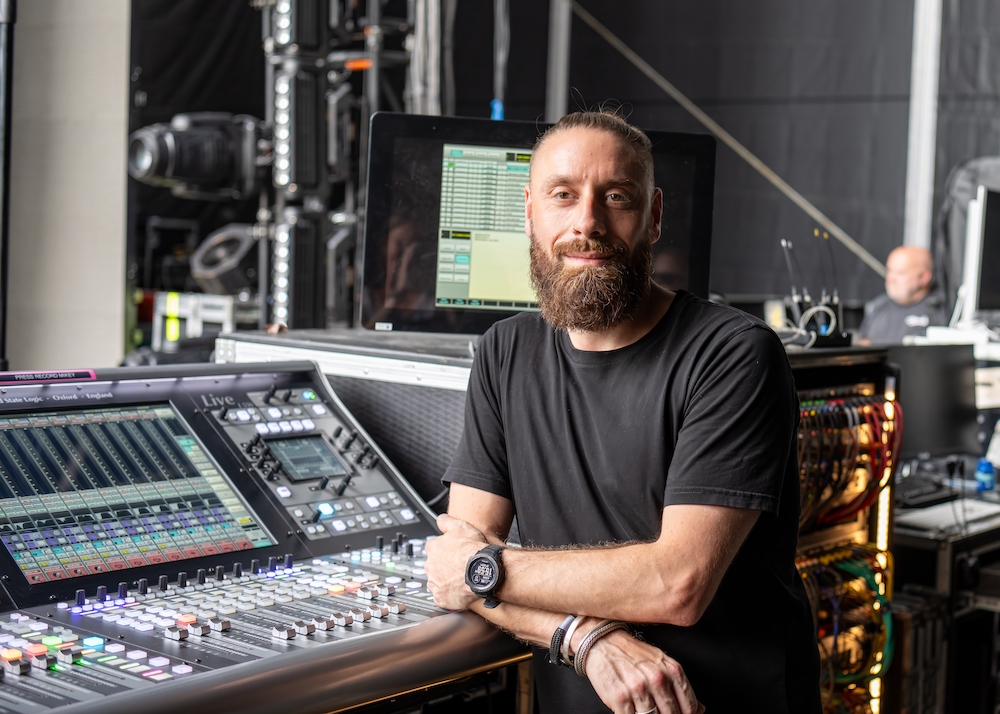
At stageside, monitor engineer Mike Gibbard oversees mixes on a Solid State Logic L550 Plus console. “I use it because of how it sounds—what comes out of the bus of that desk is ridiculous,” he said with a laugh. “The preamps are so good, the summing…. Using it almost feels like cheating; I’m good at what I do, but with that desk, I can elevate it to another level.”
While he makes use of onboard effects in the SSL, he often turns to a pair of UAD 2 Live Racks, each running at 96k and tied to a pair of DiGiGrid MGBs, for multi-tracking 128 channels; everything is clocked to an Antelope Audio OCX HD Master Clock. “I’m running 32 channels of UAD,” said Gibbard. “That’s 1176 compressors; SPL Transient Designers, mainly for the drums; a Manley VoxBox on Dave; a Manley on the guitar channels, using the tape oxide saturation quite a lot; and for reverbs, there’s Lexicon 224s and EMT 250s.”
Depeche Mode Shares That Global Spirit On Tour
Despite all that, there’s still room for outboard gear, too, with a trio of RND 5045 primary source enhancers, used to double-up vocal channels for in-ears and the d&b boxes. Alongside them sits a Radial three-slot 500 Series frame, housing a Shadow Hills Mono GAMA Mic-Pre, RND 542 Tape Emulator and an API 550A three-band EQ, all for a vocal chain. Those vocals are captured through a standard-issue Shure SM58 for Gahan and variously a 58 and a KSM9 for Gore. Much of the stage instrumentation is DI’d, and the drums are surrounded mostly by options from Austrian Audio (OC818, OC18 and OC7s), along with the occasional Audix D6, Shure Beta 91 and Audio-Technica AT4051b.
Finding the right ways to present the band’s music to the crowds and the band itself has been an unusually gratifying experience for the two engineers, both of whom are electronic music artists in their own right and were initially influenced by the band. “It’s one of the best tours I’ve ever done in my life; it’s a box-tick band for me, and they are absolutely lovely people to work for,” said Gibbard. “For me to come into this and really deliver how they want to hear Depeche Mode on stage, I’m really enjoying it, and they’re all having a lot of fun.”
